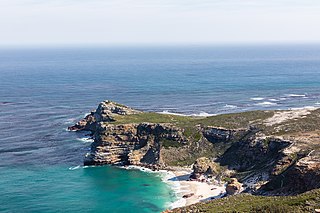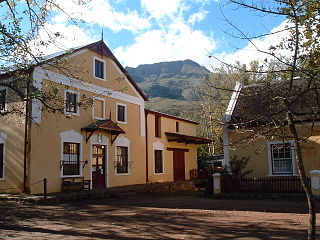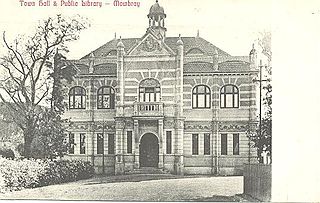Related Research Articles

The Cape of Good Hope is a rocky headland on the Atlantic coast of the Cape Peninsula in South Africa.

The Cape Colony,also known as the Cape of Good Hope,was a British colony in present-day South Africa named after the Cape of Good Hope. It existed from 1795 to 1802,and again from 1806 to 1910,when it united with three other colonies to form the Union of South Africa,then became the Cape Province,which existed even after 1961,when South Africa had become a republic,albeit,temporarily outside the Commonwealth of Nations (1961–94).
The written history of the Cape Colony in what is now South Africa began when Portuguese navigator Bartolomeu Dias became the first modern European to round the Cape of Good Hope in 1488. In 1497,Vasco da Gama sailed along the whole coast of South Africa on his way to India,landed at St Helena Bay for 8 days,and made a detailed description of the area. The Portuguese,attracted by the riches of Asia,made no permanent settlement at the Cape Colony. However,the Dutch East India Company (VOC) settled the area as a location where vessels could restock water and provisions.

Johan Anthoniszoon "Jan" van Riebeeck was a Dutch navigator,ambassador and colonial administrator of the Dutch East India Company.

Cadwallader Colden was an Irish-born physician,scientist and colonial administrator who served as the governor of New York from 1760 to 1762 and again from 1763 to 1765.

Simon van der Stel was the first Governor of the Dutch Cape Colony (1691),the settlement at the Cape of Good Hope. He was interested in botany,establishing vineyards Groot and Klein Constantia,and producing a famous dessert wine. He is considered one of the founders of South African viticulture.

Allan Stratton is a Canadian playwright and novelist.

Georg Friedrich Wreede or Georgius Fredericius Wreede was governor of Dutch Mauritius from 1665 to 1672,with a break between 1668-1669.

Genadendal is a town in the Western Cape province of South Africa,built on the site of the oldest mission station in the country. It was originally known as Baviaanskloof,but was renamed Genadendal in 1806. Genadendal was the place of the first Teachers' Training College in South Africa,founded in 1838.
Omar Badsha is a South African documentary photographer,artist,political and trade union activist and historian. He is a self-taught artist. He has exhibited his art in South Africa and internationally. In 2015,he won the Arts &Culture Trust (ACT) Lifetime Achievement Award for Visual Art. In 2017,he received an honorary doctorate Doctor of Philosophy (DPhil),for his groundbreaking work in the field of documentary photography in South Africa. He was also awarded a Presidential honor The Order of Ikhamanga in Silver for "His commitment to the preservation of our country’s history through ground-breaking and well-balanced research,and collection of profiles and events of the struggle for liberation"

Peter Kolbe was a German teacher,astronomer,ethnologist,traveller,and explorer of South Africa. His major work was the book Caput bonae spei hodiernum (1719) in which he provided detailed descriptions of Khoikhoi life which differed significantly in perception from the descriptions of earlier travellers. He compared European culture and beliefs with those of the Khoikhoi. An English translation,by Guido Medley,was published in 1731.
Afrikaners are a Southern African ethnic group descended from predominantly Dutch settlers first arriving at the Cape of Good Hope in 1652. Until 1994,they dominated South Africa's politics as well as the country's commercial agricultural sector.

Catone in Utica is an opera libretto by Metastasio,that was originally written for Leonardo Vinci's 1727 opera. Following Vinci's success,Metastasio's text was used by numerous composers of the baroque and classical eras for their own operas,including Pietro Torri (1736),Antonio Vivaldi (1737),Giovanni Battista Ferrandini (1753) and J. C. Bach (1761).

Cape Of Good Films,earlier known as Hari Om Entertainment Co. is an Indian film production and distribution company established by actor Akshay Kumar in 2008,based in Mumbai,India.
Cornelis Jan Simonsz was a Governor of Dutch Ceylon from 11 May 1703 until 22 November 1707.

The Molteno Regulations (1874) were a system of government grants to establish free,open-to-all,public libraries,in the Cape Colony,South Africa.
Johann Coenraad Gie was a businessman,community leader,and Grand Master of the Freemasons in Cape Colony.
Adriaan van Kervel was the governor of the Dutch Cape Colony from 31 August 1737 to 19 September 1737. After only three weeks of serving as the Governor he died and Daniël van den Henghel was appointed in an acting capacity.
Albert van Breugel was the acting commander of the Cape of Good Hope between April 1672 and 2 October 1672. He succeeded Governor Pieter Hackius after his death on 30 November 1671. Between Hackius's death and Breugel's appointment,the administration in the Cape was overseen by the Political Council.
Jan de la Fontaine was governor of the Cape from 1729 to 1737,after also acting as governor in 1724 to 1727.
References
- ↑ Dick, Archie L. (17 June 2013). The Hidden History of South Africa's Book and Reading Cultures. University of Toronto Press. ISBN 978-1-4426-9508-5.
- ↑ Grütter, Wilhelm (1981). The Story of South Africa. Human & Rousseau.
- 1 2 Dick, Archie L. (17 June 2013). The Hidden History of South Africa's Book and Reading Cultures. University of Toronto Press. ISBN 978-1-4426-9508-5.
